How to buy a domain name in 3 steps
What’s the importance of understanding how to buy a domain name? For entrepreneurs in the process of starting a new venture, getting a domain name is one of the first steps you’ll take to build an online presence.
You need to buy a domain name for your business so you can create a website, which will allow your ideal clients and customers to find you online.
A domain name is a big part of your business identity so it’s important to buy a domain name that will accurately represent your business and that’s easy for people to remember.
Related: What is a domain name?
This guide will walk you through everything you need to know about buying a domain name. We’ll cover:
- The steps involved in buying a domain name.
- How to choose a domain name registrar.
- How to search for a domain name.
- Tips for choosing a domain name.
- Mistakes to avoid when selecting a domain name.
- Additional considerations when you buy a domain name.
- How to register a domain name.
- Conclusion and next steps.
Ready to dive in? Let’s go!
How to buy a domain name in 3 steps
Buying a domain name may seem like a daunting process. After all, there are so many domain extensions and domain name registrars to choose from, it can be quite difficult to know where to start. However, once you know what is involved in buying a domain name, the process becomes pretty straightforward.
There are three steps that you have to follow to buy a domain name:
1. Choose a domain name registrar where you will register the domain name.
You should choose a reputable registrar company that satisfies several criteria to ensure your domain name is in the right hands. We’ll explore those criteria below.
2. Search for your desired domain name and see if it’s available.
Domain names are a hot commodity, which means your first choice might not be available. Fortunately, you’ve got plenty of options.
3. Register your desired domain name with your chosen domain registrar.
Once you choose an available domain name, you’ll be ready to register it for a specific amount of time. We’ll show you exactly how to do that, too.
Let’s go through the above-mentioned steps one by one.
How to choose a domain name registrar
The first step toward buying a domain name for your new venture is selecting a domain name registrar.
There are several factors you’ll want to consider when selecting your domain registrar, but before going into those details, let’s break things down a bit and explain a few different terms that you might come across as you’re searching for the right domain name registrar.
Registrar refers to a company, such as GoDaddy, that manages the domain name registration process. Different domain extensions (such as .com) are managed by their respective registries, but those registries don’t sell domains directly to users (aka registrants). That’s where the registrar comes into play.
Like a middle man, the registrar works with the registries in order to deliver domains to end-users.
So, now that you’re a bit more familiar with how the registry/registrar relationship works, let’s take a look at what to consider when selecting your domain registrar.
ICANN accreditation
 ICANN (or the Internet Corporation for Assigned Names and Numbers) is the governing body over domain name registrars. They provide guidelines and enforce rules that all accredited registrars must follow.
ICANN (or the Internet Corporation for Assigned Names and Numbers) is the governing body over domain name registrars. They provide guidelines and enforce rules that all accredited registrars must follow.
This is important, as it normalizes the domain name registration and management system (such as domain transfers, domain WHOIS updates, etc.). It also allows the domain customer a route for further assistance if they feel that their domain
registrar isn’t abiding by the rules set out by ICANN.
Most registrars are accredited with ICANN these days, but if you’re not sure, you can check through ICANN directly.
Complete control over your domain
There are some registrars that only provide partial control over your domain.
This could include the registrar adding their own contact information to portions of your domain details (which can make transferring your domain to a different provider much more difficult), or even preventing you from making critical updates to your domain settings (such as the ability to point your domain to your desired hosting provider).
Your potential domain provider should be able to tell you their policies on this before you register your domain name, so don’t be afraid to ask if you’re going to have full control of your own domain before you register it.
Quality 24/7 support
What’s the benefit of having full control over your domain name if you’re not able to get support for any questions that might have come up?
Choosing a provider with multiple avenues and availability for support is important.
It’s vital your domain name operates as expected. It’s the address for visitors reaching your site, and the last thing you need is to miss out on potential traffic because of a hiccup with the registrar.
A quality support team might even be able to assist you with choosing a domain. They can suggest available options, which will help you to make an informed decision about your domain name.
Pricing and domain options
Domain names aren’t generally going to be a huge expense. Most of the common domain extensions are available for in the ballpark of $10 to $20 per year. But something that you might want to consider are additional options for your domain, such as bulk registration, domain privacy, theft protection, etc.
But what do those options mean? Let’s take privacy, for example. While privacy isn’t required for your domain, it can go a long way in protecting your personal contact information.
Domain registrars are required to provide valid contact information for registered domains on WHOIS searches.
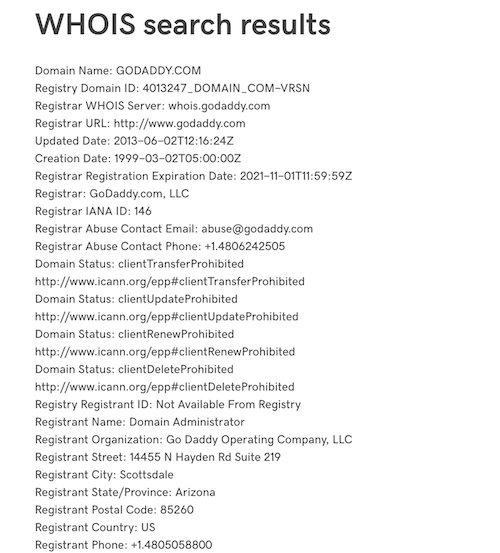
While there is a benefit to having valid contact information available there, the unfortunate downside is that spammers and scammers love to gather email contact information from WHOIS directories. In other words, privacy on your domain is a great way to protect your personal contact information. Make sure it’s available with your domain registrar before purchasing a domain.
What about additional extensions? While many businesses choose .com domains for their primary web address, there are tons of interest-, industry- and geo-specific domain extensions available that you might find more appealing.
Not all domain providers will have a wide selection of domain extensions, so if this option is important to you, make sure they’re available through your selected registrar.
Related: Domain extensions guide
Not all features are going to be as important for some users, so select a domain registrar that meets your needs and has the options that you are interested in.
How to search for a domain name
Once you have found your preferred domain name registrar, it’s time to search for your domain name. (We’re going to cover lots of tips for choosing a great domain name after we go over the logistics of conducting a domain name search.)
Your domain name shapes your online business identity and helps you connect with your target audience. Think of your domain name — the address that people type in to get to your website or use when they send you a professional email — as either the name of your business online or as a fundamental element of your overall branding.
As such, you shouldn’t put off registering a domain name for your business.
Because it’s so central to your online identity, it’s best to buy a domain name in the initial stages of naming your business.
That way, you can check on domain availability BEFORE you settle on a business name.
How to search for domains at GoDaddy
The world’s biggest registrar, GoDaddy has searching for domains down to a science. GoDaddy has an easy to use domain name search tool for mobile and desktop users, as well as a few other options for securing just the right domain name.
Simply follow these steps to register a domain name with GoDaddy:
1. Visit GoDaddy.com
Open up your preferred browser and go to GoDaddy.com. Once the home page loads, you’ll see a search bar where you can begin your domain search.

2. Enter your domain in the search bar
Enter your preferred domain name, and click Search. At this point, one of two things will happen:
If your domain name is available, great! You’ll be presented with the opportunity to add it to the cart.
If your domain name isn’t available, you’ll be prompted to search for a new domain name or select a different variation.
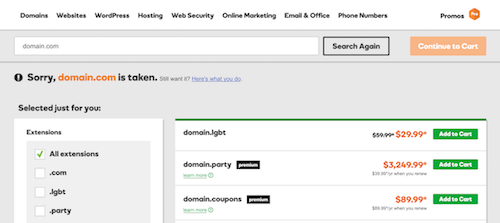
The good news? Even if your domain name is already taken, GoDaddy’s suggestion tool will list new ideas, with different extensions or variations, that you can review.
If you like one of the options, great! If not, enter a few of your other domain options into the search bar until you land on one that’s available.

Pro tip: Don’t shy away from different domain extensions. While .com is still one of the most widely registered domain endings, the availability of hundreds of new domain extensions gives you the opportunity to register a domain that perfectly represents who you are and what you do.
Go ahead, give it a try:
Other ways to search for domain names
Now that you know how to search for a domain name through GoDaddy, there are a few other channels you can use to find the perfect domain for your business.
By extensions. Depending on your business, you could find the perfect domain extension for your niche. It is easy to browse by domain extensions, all you have to do is search for available extensions by keyword, options available now, categories and more.
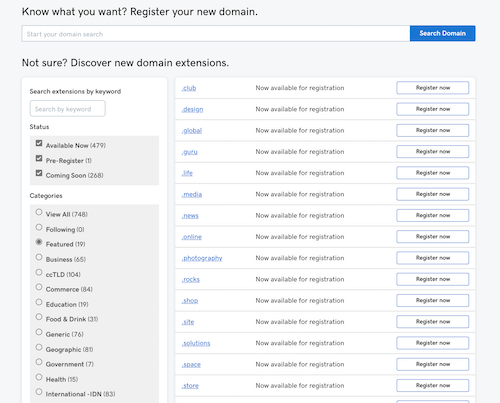
At auctions. Whether you’re looking at an expired domain name or are simply interested in purchasing a domain someone else already owns, GoDaddy Auctions is a great place to start. Searching for a domain name here is simple. Just enter your keywords or browse the listings to see what’s available.
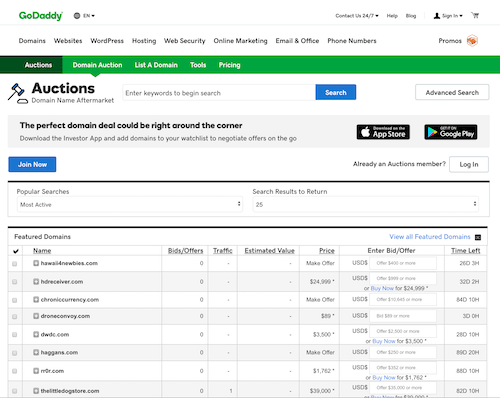
On Afternic. Domain sellers can post their domains on Afternic and have their listings sent out to more than 100 platforms worldwide. That makes Afternic a great resource for searching for a new domain name. All you have to do is enter your new search idea on the home page, and Afternic will take care of the rest, directing you to a page with available domains for sale.
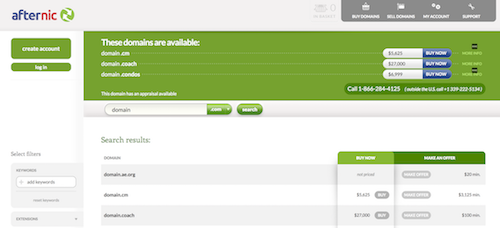
With that said, here are some top tips for choosing a domain name and which domain naming mistakes you should avoid.
Tips for choosing a domain name
Finding a domain that’s available, valuable and relevant is important to online success, which is why registering a domain name requires strategy.
Choosing a domain name that points out your value proposition (what makes your business special), vertical (what space you operate in), or geographic area can help you drive business and stand out from the competition.
Consider what do you do and where you do it
Your domain name should be indicative of your venture. To start, list out the following information to get a better idea of what you can possibly incorporate in your domain:
- Business industry (e.g. bakery)
- Services (e.g., catering)
- Products (e.g., cupcakes)
- Geographic location (e.g., New York City)
- Words that describe your business (e.g., delicious, decadent, custom, sweet, supreme)
Use that list to brainstorm a variety of short, memorable and representative domain names. Be sure to check out industry- and geo-specific domain extensions including .catering and .nyc.
Keep it short and simple
It’s an obvious strategy, but registering a domain name that is short and memorable isn’t as easy as you might think. The fewer words or characters your domain name has, the more likely your customers will spell your domain correctly and find your site. This method might require some creativity, but it will pay off.
On the “simple” front, make sure your domain name is easy to spell and avoid using numbers and hyphens.
Do some research
Research your potential domain name on social media and trademark databases.
The key to building a successful brand online is consistency so it’s advisable to keep your social media handles the same as your domain name.
Also, take some time to run your domain name through the trademark database.
Determine value
Domain names are valuable. People buy and sell domains every day for more than the normal registration price. Another helpful data point to check is GoDaddy’s free Domain Appraisal tool. It can give you an idea of the potential value of your domain choice.
Why is this important?
They fit many of the important factors that help contribute to online success in naming, such as popular usage, memorability and branding.
Related: 10 tips for choosing the perfect domain name
Mistakes to avoid when selecting a domain name

Your domain name is your business’s unique identifier on the web, so it’s super-important that it makes the right impression. If you avoid these five domain naming mistakes, you’ll be well on your way to making that happen.
1. Don’t fart (or, avoid an embarrassing mishap)
True story: A metal artist named Frank signs all of his artwork with a single letter “F.” He searched for a domain name that exactly matched his business name when planning to start his website for F Art Gallery.
The gallery’s domain sounded great when written with the appropriate spaces — but not when typed into a web browser. Sure, fartgallery.com was memorable — but not likely the kind of memory Frank wanted to leave with potential customers.
When you think about your website address, think about it as a sequence of words and letters in a sequence, rather than as separate words. You’ll save yourself some embarrassing looks when people see your new domain on a business card or email address.
2. Don’t show off (or, try too hard to be clever)
The point of doing business online is to make it easy for people to find your website and take whatever action you want them to take — check out your products and services, call you for estimates, buy your widgets, whatever.
If you want people to easily find you, don’t make it hard for them to remember your website address by choosing a domain name that takes liberties with language simply for the sake of being clever.
Also, consider the international spelling of words. If you use a word like “colour” and your business is primarily doing business in the U.S., expect to lose potential customers typing your domain with the American spelling of “color.”
Clever is cute, but using a clever spelling of a domain makes it harder to market your business online.
3. Don’t stunt your growth (or, name yourself into a corner)
When choosing a domain name, it pays to think ahead.
For example, you might want to avoid including the one product you sell now in your domain name if you plan to expand your product line in the future. Likewise, including a location is your domain name is a smart move if you’re planning to do business locally but could stunt your online growth if you’re planning to expand to new areas.
Give yourself room to grow.
4. Don’t be antisocial (or, pick a domain that’s not available on social media)
Check social media before settling on your new domain. As mentioned earlier, the ideal situation is to claim social handles that mirror your domain name.
Related: How to claim social media handles — and why you should do it now
5. Don’t sell yourself cheap (or, avoid premium domains)
Another true story: An entrepreneur went looking for the .com version of a business domain and it was already taken, but for sale on the domain aftermarket for $2,500 — a price he considered too high to shell out for the ideal domain name. He decided to go with the .net version because it was available at a normal price.
Within a few years, the business exploded; their product was everywhere. This happy entrepreneur then decided to invest in the .com version of the business’s domain name.
Here’s the catch: A lot of people had been typing .com instead of .net when searching for the business’s website. The impressive number of “hits” to the parked web page attached to the premium .com domain had spiked its price to $15,000.
So, if you know you want a domain for your business and it’s available as a premium domain, save up and invest in the perfect domain at the beginning. You can save yourself money in the long run.
Additional considerations when you buy a domain name
Before you rush out and register your domain name (we’ll cover exactly how to do that in a minute), there are a couple of things you need to keep in mind — the cost of the domain and domain privacy.
How much does a domain name cost?
The cost of your domain name will depend on a couple of factors:
- The extension you use.
- Where you buy the domain name — a reputable registrar, a private seller or an aftermarket service?
- The length of time you’re registering the domain for as well as additional options chosen such as domain privacy, etc.
In general, regular domain names range between $10 and $20 per year, depending on the extension and available discounts or special promos that registrars have active.
If you’re looking into buying a premium domain, you can expect to pay upwards of hundreds of dollars. However, there is no definitive answer nor a minimum range for premium domains.
The best way to get a feel for the domain cost is to enter the potential domain name in GoDaddy’s Domain Appraisals tool and to browse sites like Afternic and GoDaddy’s Domain Name Aftermarket.
Should you add domain privacy (private registration)?
Another consideration to keep in mind is to decide whether you want to add domain privacy or not. Domain privacy allows you to hide your private information so nobody can see it when they perform a WHOIS lookup. This is useful as it protects your information from getting scraped and used by online scammers and spammers.
You can easily add domain privacy during the domain registration process.
GoDaddy offers full domain privacy and protection packages for both individuals and businesses. This service protects your private information, prevents domain-related spam, and it can also safeguard your website from accidental loss of domain due to expired credit card, potential hacking attempts, and deter domain hijackers.
How to register a domain name
Wow — we just covered a lot of territory. Now it’s time to get out there and register a domain for your business.
How to register a domain name with GoDaddy
If you’re ready to make your mark on the internet but are not sure how to actually register your domain name, here’s a step-by-step process for registering your available domain name with GoDaddy.
1. Enter the domain name in GoDaddy’s domain name search bar.

2. Click Add to Cart.
3. If desired, register additional extensions to protect your online brand. Click Add to Cart for each additional domain name.
4. Click Continue to Cart.
5. Select a domain privacy plan, or click No Thanks.
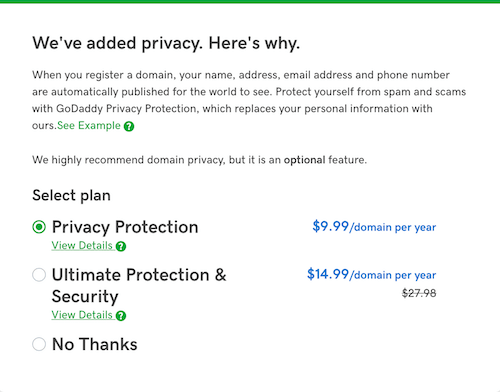
6. Decide if you want to attach your domain name to a free starter website.

Keep the box checked for “Start your website for free” if you want to attach your domain name to a free trial of GoDaddy’s Website Builder. Uncheck the box if you want to pass.
7. Decide if you want to attach your domain name to a professional email address.
Choose from three professional email plans or keep the box checked to No Thanks.
8. Click Continue to Cart.
9. Sign into your GoDaddy account or click Create Account.
You’ll be prompted to enter your billing and payment information. GoDaddy offers several payment methods so choose the one that’s most convenient for you. You will need to provide your billing address but if you’ve chosen domain privacy in the previous step, that information will not be visible to the public.
10. Review your order under My Items and click Complete Purchase.
Consider registering your domain name for a longer term to save money in the long run and prevent accidental domain expiration.
Congrats, you now understand how to buy a domain name and are the proud owner of a new online identity. It’s time to get your brand on the web!
Conclusion and next steps
Buying and registering a domain name for your business might seem daunting, but once you know what’s involved in the domain registration process, the whole experience becomes much easier. Let’s quickly recap how to buy a domain name:
1. Select your domain name registrar
The first step is to find a reputable domain name registrar that you’ll use to register your domain name. While there are many domain name registrars out there, you need to make sure that your chosen registrar meets several criteria:
- They are an ICANN accredited registrar.
- They provide 24/7 quality support.
- They give you complete control over your domain name.
- They offer affordable domain names, several payment methods, and additional options such as domain privacy, bulk registrations, and additional extensions.
2. Search for your desired domain name
After you have chosen your domain registrar, you will need to search for your domain name and see if it’s available. For this part of the process, you will want to keep the domain naming tips in mind:
- Keep it short and simple.
- Consider combining what you do with your location for a unique domain name.
- Consider registering additional domain extensions.
- Avoid domain naming mistakes such as choosing a name that’s too specific and doesn’t allow you to grow, not checking the domain name spelling, or trying to save money by not buying a premium domain.
3. Register your domain name
The last step is to actually register the domain name. GoDaddy makes buying your domain names a breeze so once you have found your perfect domain name, add it to the cart and then create your GoDaddy account. You will then enter your payment and billing information, add extra options such as domain privacy or additional extensions, and complete the purchase.
Next steps
Now that you have your perfect domain name, it’s time to take the next steps toward creating a memorable online identity for your brand.
Get a professional email that matches your domain name
If you opted not to take this step during the domain buying process, give it some thought now. An email address that is attached to your domain name will add to your brand credibility and make you look more professional than a plain Gmail or similar email address.
Create a website
Your website will become your online home so it needs to have a professional design, tell people what you do, and allow them to easily hire you or buy from you. Read our guide on how to start a website for an in-depth look at your options.




0 Comments